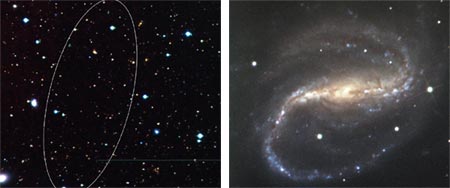An international team of astronomers has discovered what appears to be an invisible galaxy made almost entirely of dark matter – the first ever detected. The mystery galaxy, VIRGOHI21, lies in the Virgo cluster of galaxies, some 50 million light-years from Earth.

Astronomers know that the visible galaxies contain more than the luminous matter observed; the rotation velocities indicate the presence of haloes of large amounts of dark matter. However, simulations of cold dark matter in the universe predict more dark haloes than galaxies, leading to the idea that there are dark haloes without stars: dark galaxies.
The team, from the UK, France, Italy and Australia, has been searching for dark galaxies by studying the distribution of hydrogen atoms throughout the universe through their emissions at radio wavelengths, in particular using the 21 cm line of atomic hydrogen. VIRGOHI21, a huge cloud of neutral hydrogen with a mass 100 million times heavier than the Sun, was first seen with the University of Manchester’s Lovell Telescope at Jodrell Bank, UK. The sighting was later confirmed with the Arecibo telescope in Puerto Rico.
The speed at which it spins indicates that there is more to VIRGOHI21 than hydrogen. The rotation velocity implies a mass 1000 times greater than the amount of hydrogen, and at the distance of the Virgo cluster this should be in the form of a galaxy shining at 12th magnitude. However, when the team studied the area in question using the Isaac Newton Telescope in La Palma, Canary Islands, they found no visible trace of an optical counterpart for VIRGOHI21.
Dark galaxies are thought to form when the density of matter in a galaxy is too low to create the conditions for star formation. The observations of VIRGOHI21 may have other explanations, but they are consistent with the hydrogen being in a flat disc of rotating material – which is what is seen in ordinary spiral galaxies. Similar objects that have previously been discovered have since turned out to contain stars when studied with high-powered optical telescopes. Others have been found to be the remnants of two galaxies colliding, but in this case there is no evidence for such an encounter.
The team first observed the dark object in 2000, but it has taken almost five years to rule out the other possible explanations.
Further reading
R Minchin et al. www.arxiv.org/abs/astro-ph/0502312.








